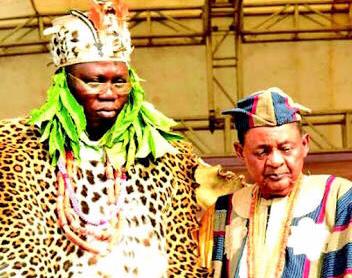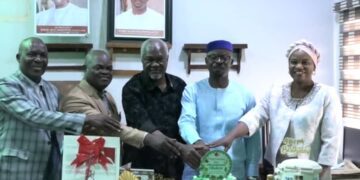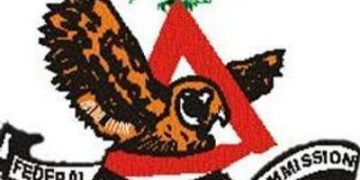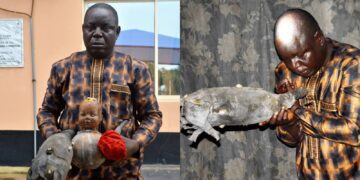The rich culture of the Yoruba will once again begin to unfold from the 9th to The 13th of January 2019, as the Ààrẹ Ọ̀nà Kakaǹfò Iba Gani Adams, marks his one year as the Supreme Head of the Eshos, by installing his own Chiefs…
To understand the institution for The Ààrẹ, we must go back to Aláàfin Ajagbo mogun ń létí, a lè elemele, who felt the need to create such an exalted position to complete a process of a unique modern system of government that gave the Yoruba empire a clear advantage over all other empires in the West African region about the year 1550.
An Ààrẹ is crowned, coronated with certain ensigns and insignia of office that remain till today, an exclusive of the Ààrẹ.
On the head of the Ààrẹ sits the *”Ojijiko”* crown, a unique coronet that is truly crown shaped, fitted with the oxblood feathers of the parrot’s tail, the leopard skins he wears like an apron and sits on too and his unique staff upon which he becomes the head of all the Yoruba warriors…. It is only the next natural step for the Ààrẹ to appoint his Chiefs along the lines of the old order.
One may indeed be forced to enquire as the reasons why The Ààrẹ’s predecessors of SLA Akintola and MKO Abiola did not seem to have appointed their own Chiefs…
The answer is simply this:
When Chief SLA Akintola became Kakaǹfò in August of 1964, it was at a time of a huge political dynamics, in which Akintola as premier was more involved in governance and political survival than in tradition.
Regarding Chief MKO Abiola’s case, his refusal to carry out the full coronation rites due to his strong Islamic leanings prevented a continuation of a tradition that is over 500 years old.
For instance, the Ààrẹ Gani Adams did all the full traditional rites of passage, including the 201 incisions, “gbẹ́rẹ́”, on his head and went through all the rituals progressively, from the Shango shrine, after having done similar initiations at Obatala’s shrine, Ogun’s shrine, Eshu’s shrine and in conversation with The Earth Mothers of the Bird fraternity.. Awon Iyami Osoronga, among other rites …!
It was the moment Shango gave the final Blessings that Iku Baba Yeye himself, proclaimed him the New Kakanfo! The full Kakaǹfò and not just a ceremonial Ààrẹ.
The rites of passage Ààrẹ Gani Adams passed through to become the Kakanfo, should be considered more deep, more intense than what some major Obas go through to becoming kings..
An Ààrẹ, especially The Kakanfo, is a king in his own right.
The Ààrẹ of old did the same, everywhere.
There was Otun Ààrẹ, and Osi Ààrẹ among others…
Asubiaro Latoosa, was Otun to Òjó Aburumaku before he became The Substantive Ààrẹ. Ikurunmi Ọkọ Mosadiwin of Ijaye, Also had his Chiefs along with the 70 Eshos, who were also Chiefs of sorts…
And didn’t Latoosa as Ààrẹ have his own Chiefs!??
Lest we forget, this present Ààrẹ is of the mold of the Ààrẹs of old… He is Not the Akintola or Abiola type Ààrẹ, but an Ààrẹ of the Yoruba, akin to the type we had in times of certain conditions of insecurity to the Yoruba Nation.
It is therefore a strategic decision to address a particular need to have war time Chiefs, to further help in protecting the Realm from the incursion of the “Usual suspects”, into our land…!
Lest we also forget, during the time of Aláàfin Ajaka, to Eguguoju, Abiipa, Oluaso, up to the time of Aláàfin Jeayinfa, the Ìbàrìbá armies worried the Yoruba greatly and the Aláàfin had to appoint Ajagun-ńlá of Ìlá-ọ̀ràngún tó lead the Yoruba armies and Ajagun-ńlá appointed Onikoyi, Olugbon and Aresa as his own Chiefs, who are today important Kings in Yorubaland, that was around the year 1430.
Therefore, when Aláàfin Ajagbo installed Kòkòrò gangàn of Ìwòye as the first Ààrẹ, majorly to check the incessant attacks of the Ìbàrìbá, the Ààrẹ also in the continuation of the process of defending the realm, appointed his own Chiefs… Here was the beginning of the appointment of the 16 upper Chiefs and the 54 lower Chiefs…
This is significant.
Any serious culturally conscious Yoruba, will know that in Odu Ifa, there are 16 principal Odùs and 240 asopo Odùs..
The Ààrẹ is Lord over the 4 administrative corners to which the Yoruba empire was divided into for easy administration and for each of the “Ẹkùns”, or parts, Ẹkùn òtún, Ẹkùn òsì, Ẹkùn Ebolo and Ẹkùn Èpò, The Ààrẹ places 4 of the principal Chiefs…
The Otun Ààrẹ, Òsì Ààrẹ, Bashorun Ààrẹ, Jagun Ààrẹ, Agbakin, Olorogun, Aareago, were of the principal 16 Chiefs of the Kakanfo.
Collectively, they are know as the Ẹ̀ṣọ́, an elite group of fearless, fearful warriors who defended the realm and their Ẹkùns, answering to their Generalissimo and by Extension to the Sovereign, The Aláàfin as the imperial King of the Realm.
Whilst the Cabinet Chiefs, the Bashorun as the Prime minister, the Shaamu, Alapinni, Kudefu, Laguna, Akiniku, are Chiefs by their rights to generational lines, the Chiefs of the Kakanfo are not. Like the Ààrẹ, they are chosen by the very process of their Valor and bravery…. By their loyalty to defending the Yoruba space as by being a True Ẹ̀ṣọ́, the Brave. A reward of merit only, not social standing, qualifies one to be made a chief of the Kakanfo.














